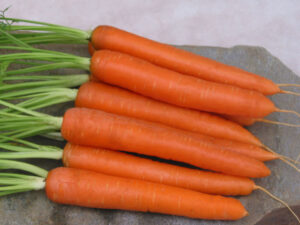
Transplanting carrot seedlings, including the ‘Samantha Nantes’ variety, can be a delicate process due to their sensitive root system. Generally, carrots are better off when direct-seeded, but if you’re working with seedlings, here are some guidelines:
Samantha Nantes Carrot Description
- Appearance: ‘Samantha Nantes’ is a variety known for its straight, cylindrical shape and smooth skin.
- Color: Typically a vibrant orange.
- Taste: Renowned for its sweet flavor and crisp texture.
- Size: Usually grows to a length of 15-20 cm.
Soil and Climate Requirements
- Soil Type: Prefers well-drained, sandy loam or loamy soil. Heavy or clay soils are less ideal.
- Soil pH: Optimal pH is between 6.0 and 6.8.
- Climate: Cooler climates are preferred, but adequate growth can occur in a range of conditions as long as extreme temperatures are avoided.
Sowing and Transplanting
- Germination: Carrot seeds typically germinate in 10-20 days.
- Seedling Age for Transplanting: Transplant when they are 3-4 weeks old to minimize root disturbance.
- Handling: Handle with care to avoid damaging the taproot.
- Spacing: Transplant seedlings about 3-5 cm apart, with rows spaced 20-30 cm apart.
- Planting Depth: Keep seedlings at the same depth they were in their growing containers.
Watering and Maintenance
- Watering: Keep the soil consistently moist, especially during establishment and root development.
- Thinning: If necessary, thin the plants to about 5-8 cm apart after they have established.
Pest and Disease Management
- Common Pests: Be vigilant against carrot rust flies, aphids, and nematodes.
- Disease Control: Ensure good soil drainage and practice crop rotation to prevent soil-borne diseases.
Harvesting
- Maturity: ‘Samantha Nantes’ carrots typically reach maturity in about 70-80 days.
- Harvesting Signs: Harvest when carrots have reached the desired size and show a rich orange color.
- Method: Gently loosen the soil around each carrot and pull carefully to harvest.
Additional Tips
- Transplanting carrots is less common due to the risk of damaging the taproot. Direct sowing is generally more successful.
- If transplanting is necessary, use a dibber or similar tool to create a hole for each seedling, which helps minimize root disturbance.
While these are general guidelines, local environmental conditions can significantly influence the exact requirements and care. It’s advisable to adjust practices based on your specific climate, soil type, and local agricultural recommendations.





Reviews
There are no reviews yet.